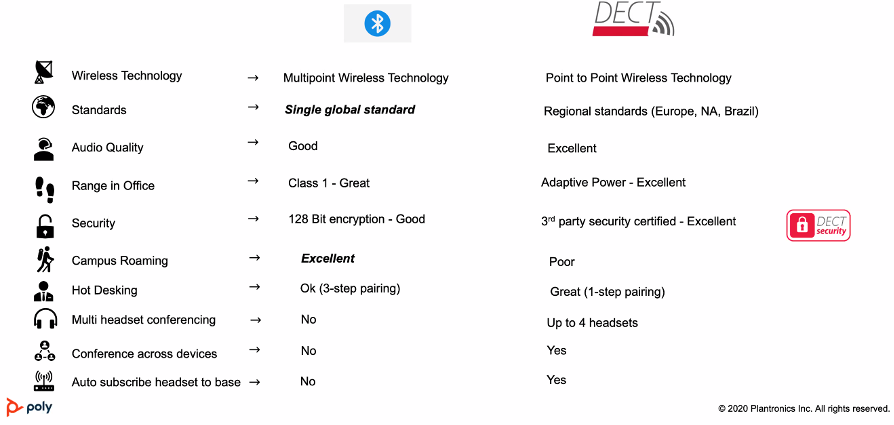Bluetooth vs DECT?

If you’ve been looking for wireless headsets or cordless office phones, chances are you have stumbled across either DECT or Bluetooth options. Many of us are already familiar with Bluetooth, the standard for mobile phone connections to cars, headphones and even mice and keyboards to our computers – but what about DECT?
If you’re familiar with VoIP, you may be familiar with DECT, but the differences between the two are not so clear. When purchasing new technology for the office, there is not so much a gold standard of DECT or Bluetooth over the other. It will really come down to how your workers will utilize the technology. Both Bluetooth and DECT have their own benefits and advantages, but which you adopt will depend on how your office functions.
What is DECT?
DECT, or Digital Enhanced Cordless Telecommunications (or Digital European Cordless Telecommunications), is a wireless standard mainly used for cordless telephone systems and accessories.
As the major standard for most of the world’s markets, DECT is utilized for both consumer and business VoIP phones, and can be used with either a PBX or wireless LAN.
Connection of DECT devices is done through a “base station” – phones and headsets will be connected and linked to a base station, as opposed to directly to the computer (or phone for headsets) themselves. While this adds an extra layer of hardware, one base station can power multiple devices – and can be stringed together through an office to create a usable range far superior to anything Bluetooth could manage.
What is Bluetooth?
While most of us will be familiar with Bluetooth, it still serves to offer a quick introduction and recap of the technology to offer a proper comparison. Bluetooth was first created in 1994 as an alternative to data cables, for exchanging data through radio transmissions. Reaching consumer technology in 2000, Bluetooth has been one of the standards for music and audio streaming around the world.
Bluetooth is simply a wireless communication protocol for connecting devices and allow the wireless transfer of data. Slower than Wi-Fi, Bluetooth isn’t totally applicable for all use cases, but is generally very simple to setup and works across a wide range of devices such as cell phones, headphones, headsets, tablets, computers, remotes, and printers.
Going through many renditions, we’re finally up to Bluetooth 4.2 which has seen improvements in transfer speeds, security and reliability throughout the years. Some of the unique benefits of Bluetooth include the ability to connect up to 8 devices at once, and a user experience taken for granted – with one of the easiest ways to connect and pair devices, sometimes requiring only a 4 digit, or more, custom PIN.
The DECT vs Bluetooth debate has been a long one, and the decision to adopt either Bluetooth or DECT as the wireless standard for your office will mostly come down to you and your office’s needs. Each has its strengths, and slight weaknesses, but this isn’t truly a case of one absolutely defeating the other.
DECT:
- Designed with a focus on telecommunications and stronger use case for voice
- Can only connect to a base station and one other device
- Still secure-enough 64-bit encryption
- Range specific to each device, but capable of 300 to 500 feet in most cases
If users only need to have their headset to work with a desk phone or computer based softphones, chances are DECT is the way to go. DECT would also make sense for open offices, or those particular to wandering around to take full advantage of the massive range DECT provides. DECT makes a lot of sense for call or contact center agents.
Bluetooth:
- Can have a total of Eight devices connected at once
- A more secure 124-bit encryption connection
- Has a wider use with a greater choice of compatible devices
- Class two range is limited to about 33 feet
Bluetooth makes total sense when headsets will be used with desk and mobile phones, or any other devices. Because of a wider range of capability, Bluetooth makes sense if your workforce is more mobile and works remotely. For these teams, the ability to take their headset with them will be key. Range can also be mitigated when using a headset with a mobile phone, because we all keep our cell phones in our pockets anyway.

Still not sure? Have a look at our range of headsets or sign up for a free, no obligation live demo.
